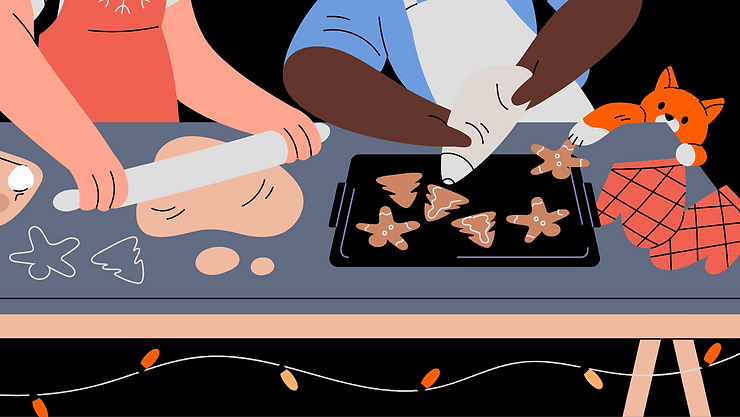Kitchen's festive feast- How to perfect the sales development process
As the festive season fast approaches, many will find themselves preparing to cook up a feast! Yet, often the thought of making a grand dinner for the family will be met not with excitement, but trepidation and stress...

This overwhelming feeling is similarly experienced by many SDRs throughout their daily grind - but it doesn’t have to be this way. Ultimately most of us know how to prep the vegetables, roast a turkey, and set the table. Just like most SDRs know how to research a prospect, pick up the phone, and set a meeting.
So what makes cooking Christmas dinner and sales development so stressful?
The honest answer is the pressure you put on it, combined with the idea of having to bring all of the elements together to make the perfect meal or provide your salespeople with the perfect SQL.
All I want for Christmas is you, Mr Turkey

When reflecting on my previous editions of Kitchen’s Takeaways in preparation for this festive feast, I noticed that almost by accident I’d spent 90% of my time discussing phone conversations. I came to the realisation that the phone call is the turkey of the Christmas dinner. Families won’t eat turkey at all throughout the year, but the very mention of duck or nut roast alternatives for the holidays are met with scoffs of disapproval.
So with that dietary caveat in mind; LinkedIn, other socials, emails, inbound forms, content downloads, personalised video, and SMS are all incredibly valuable tools in your sales development arsenal. But it’s well established that speaking to someone on the phone is going to be the most instant way to schedule sales meetings; with a shocking 59% of decision-makers thinking that a sales email will only contain irrelevant information! So, much like turkey on December 25th, calling still reigns supreme.
Therefore, I thought it would be best to go through the calling process from the pre-call research all the way through to post-call follow-up, and how to use outbound phone outreach to generate leads.
T'was the night before calling

The more prep that can be done ahead of time, the easier the task will be on the day. Veggies can be chopped, pigs can be wrapped in blankets and the turkey can be stuffed and basted. The same rings true for a conversation, or any engagement for that matter.
My top 5 call prep items:
-
Go into the call with a direct referral from a colleague to speak to this person
-
The knowledge that the decision-maker has worked previously at a current/ previous customer of yours
-
The knowledge of personal (but not sensitive) information about the individual you’re reaching out to, or their team/department.
-
The knowledge of current relevant buying signals or business events OR knowledge of individual tenure, promotions, or place within the business
-
At a bare minimum: the knowledge of the person’s role, why they’re likely the right decision-maker, and why they and their business are ideal for the offering
TIP: Asking for a referral often doesn’t come across well, it seems as if it may be inconvenient to the person you’re speaking with, and they don’t want to send an email for you or introduce you to the decision-maker. A winning line can be to simply say "based on the conversation we’ve had here today would you be happy for me to reach out to your (named) colleague?"
Let it snow, and the conversation flow

Once everything is in the oven or bubbling away on the stove, there is a sigh of relief with the feeling that all one has to do now is wait. It can be exactly like this in a sales conversation, after getting past awkward introductions and initial qualification questions, the conversation can settle into a rhythm.
There are lots to remember when it comes to extracting important qualifying information, handling objections, and eventually navigating your way to a successful close (more on this later). But the key takeaway here is that every conversation is different, and just like cooking instructions on the back of the package if you take them with a pinch of salt, follow best practices and trust your eyes, you’ll end up with the best-cooked dish.
Best Practices
-
Slow down! If I had a cracker for every time I’ve told an SDR this, I’d have a joke and a party hat for every day of the year. It’s basic but it’s true. Most people speak at around 150 words per minute, public speaking and the most persuasive form of speech is slower at around 125 words per minute. But my estimation during a sales call is that SDRs speak at around 200 words per minute!
-
If you can’t speak slower… speak less. Open questions and staying silent with affirmative noises keep the responsibility of the conversation on the other person.
-
Repeat stuff! Active listening involves a lot of repetition, it also ensures that nothing gets misinterpreted during a conversation.
-
People’s favourite topic... themselves. Ask ‘you’ questions to keep a prospect engaged (I often make this into a game where every question I ask has to include the word you).
-
Don’t focus on the outcome. Instead, focus on your performance and demeanor in the conversation. If you’re asking the right questions and have effectively piqued the prospect’s interest the opportunity will present itself. Santa won’t come if you stay up waiting for him, just like closing won’t happen if you’re trying to close from the moment the person picks up the phone.
Closing time, mistletoe and wine

Closing is crucial and lots of my previous takeaways have been based on how to do so effectively and with flair. This pivotal moment in a conversation is like dishing up dinner - ideally, everything should be ready to be served and piping hot at the same time. Equally, if soggy vegetables and a more ‘hacked’ than carved turkey is served, the hours of effort in making the meal can all be for nothing.
When it comes to closing, the old adage I’ve mentioned in other pieces is Always Be Closing. But I think as it’s approaching the end of the year it’s time for a refresh and a new acronym.
Ask another question. If someone declines the invitation to a meeting, pushing repeatedly can be futile, ask another question about the individual, and get more information that can eventually bring you back to another opportunity to close.
Bring something to the table. A prospect needs to see value from a meeting, otherwise, they’ll consider it a waste of time. Don’t be offended by this, they may well think the same about lots of their meetings. Provide the prospect with enough information to pique their interest but don’t over-egg the pudding! Help the prospect see the value of your offering for their business challenges.
Change your close. Asking the same question three times is a recipe for disaster. Change up your invitation for a meeting by making it feel different each time. If you base it on different reasoning or newly acquired information you’ll have more chance of getting a different response.
Don't have a blue Christmas

No one wants to clean a kitchen that looks like a bomb has gone off, especially when you’ve got a full belly and had one too many sherries. The key is to clean as you go and be economical with your cookware and utensils.
Being economical means asking questions that have easy follow-ups and ensuring you ask just one question at a time to engage the prospect rather than confuse them.
Cleaning as you go means getting as much information as possible, and neatening up the opportunity in the most conversational way. If a prospect tells you about a system they use, some holiday they have booked, or maybe mentions an email, then drop in a quick question to help qualify the opportunity. For example- find out when they’re back from holiday and suggest a meeting a few days after they’ve settled back in.
Step into sales development

Now all that remains is to sit down and enjoy your meal. Hopefully, this guide provides some useful insights for anyone working in sales development, that might be stressing like it’s Christmas dinner, trying to bring all the elements of a call to reach out together.
Maybe next year we’ll talk about dessert.
Oh, and one last COOKING TIP for good measure- use vegetable water and just a drop of fat rather than just boiled water for a delicious gravy.
Happy Holidays!
Previous Post
Kitchen clean-up
Next Post




